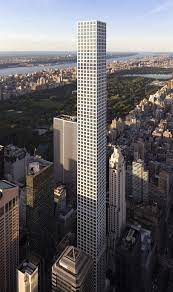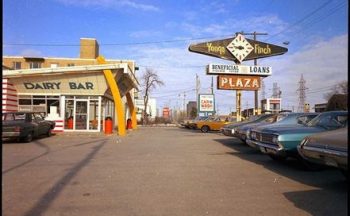 A new class of high-rise structures, those reaching 65- to 95-stories, or more than 250 metres in height, are supertall buildings. The costs of maintaining these structures are considerably higher although little is known about them. Aura and One Bloor (when completed) are the only residential buildings currently achieving this stature. At least 10 additional supertall buildings are planned for Toronto including the 95-storey Concord Sky at Yonge and Gerrard, and Forma in the King Street theatre district which will include 84- and 73-storey towers.
A new class of high-rise structures, those reaching 65- to 95-stories, or more than 250 metres in height, are supertall buildings. The costs of maintaining these structures are considerably higher although little is known about them. Aura and One Bloor (when completed) are the only residential buildings currently achieving this stature. At least 10 additional supertall buildings are planned for Toronto including the 95-storey Concord Sky at Yonge and Gerrard, and Forma in the King Street theatre district which will include 84- and 73-storey towers.
Most condominium buildings are no higher than 65 stories. Maintaining buildings of this height are known although different from what we expect in the typical 12- to 25-storey building.
Views from higher floors can’t be beat, although high winds are a challenge. Higher balconies can be unusable because of strong winds which can also cause more damage to higher levels. Closing windows and balcony doors can be difficult. A constant whistling or shrieking sound is not uncommon.
Window cleaning is one of the biggest challenges. Insurers can be hesitant to insure cleaning beyond 50 storeys. Cleaning takes longer and can encounter more delays because of wind and cold temperatures at upper levels. Employees working at higher levels command a higher salary to compensate for increased difficulty.
The scale of supertall buildings will change much of what is understood about maintaining high-rise buildings and costs.
Major equipment can no longer be located exclusively on a roof or in the basement, both of which are too far away to adequately service an entire building exceeding about 30 storeys. Locating this equipment mid-level is necessary which can create unwanted noise and vibration affecting nearby suites. Replacing larger equipment becomes more complex.
Higher buildings have more residents and floors. Coming down from the top floors, elevators can be full before they are half-way to ground level. Individuals on the middle or lower floors can wait an exceptionally long time for access to an elevator. Going up, there can be long lines in the lobby.
Height creates challenges to the delivery of water, heat, air conditioning, ventilation, internet services and cellular reception. Ensuring all suites receive adequate service requires equipment to be placed throughout the building.
From daily access to repairs and renovations, everything is likely to take longer because of height and number of floors. If an elevator is reserved for a move or out of service, delays worsen. Projects cost more and take longer to complete. Contractors get paid to stand around waiting to access an elevator, or for supplies to arrive.
Repair budgets are likely to escalate. One 65-storey building includes a crane assembly used to allow window washers to clean windows. There is a budgeted expense of about $15,000 every 20 years for repairs. The crane extends beyond the walls so window washers can drop down. Replacing a damaged cylinder requires another roof crane to raise a new cylinder from the ground. Cost of this crane is about $250,000 and the cylinder costs $60,000 to replace. Replacing large glass wall panels requires another temporary crane to raise new glass panels.
 First Canadian Place was one of the first supertall buildings to be updated, in 2012, at a cost of more than $100 million. While no supertall residential building has yet undergone an extensive refurbishment, it is safe to expect the cost to be “super”. Condo fees in a supertall building may be double that of shorter buildings.
First Canadian Place was one of the first supertall buildings to be updated, in 2012, at a cost of more than $100 million. While no supertall residential building has yet undergone an extensive refurbishment, it is safe to expect the cost to be “super”. Condo fees in a supertall building may be double that of shorter buildings.
Management is a challenge if one condominium manager is required to manage a much larger building with many more people. New budgeting levels, processes and systems are needed. The balance between keeping costs low and not underfunding repairs will have to be relearned. More people trying to access a single exercise room, swimming pool or showers creates new obstacles.
Volunteer condo boards struggle to manage their current high-rise community and building. Supertall buildings may be unmanageable by volunteer condo boards without greater involvement from professional management.







